MAE 343_Class 8
advertisement
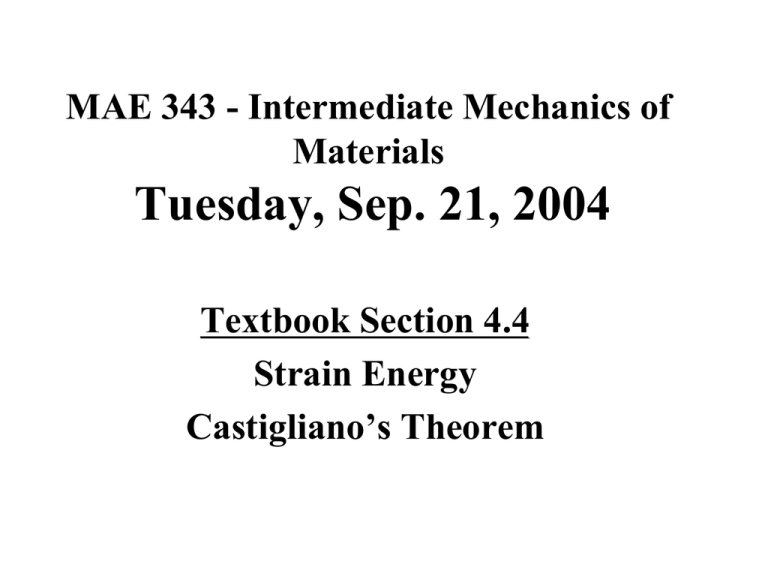
MAE 343 - Intermediate Mechanics of Materials Tuesday, Sep. 21, 2004 Textbook Section 4.4 Strain Energy Castigliano’s Theorem Overview of Loads ON and IN Structures / Machines Structural Analysis Applied LoadsForces &Moments Body forces &couples Reaction Forces & Moments (at supports) From FBD of entire structure Surface forces&couples Flow Lines from Applied to Reaction Forces Resultants on Cutting Surface From FBD of Part of Structure Equilibrium Eqs. (3 in 2D, 6 in 3D) Concentrated FBD of Each Component from Forces through Contact Surfaces Distributed / Pressures Internal Forces & Moments Depend on Location& Orientation of Cutting Plane Equilibrium Eqs. (3 in 2D, 6 in 3D) Shear Force & Bending Moment Diagrams Overview of Various Stress Patterns Stresses- from Distribution of Internal Forces over Given Cross-Section Uniaxial Tension or Compression of Straight Bars or Lap Joints Pure Bending of Long Beams Beams Subjected to Transverse Forces Torsion of Round or Prismatic Shafts Uniform Distributions of Stresses Neutral Axis at Centroid of Cross-section Transverse Shear Stresses Result (Add-up) in Shear Force in the Cross-Section Moment of differential torsional stress about centroid results in the internal torque in cross-section Normal Stress-Straight Bars Sigma=F/A Linear Distribution over from Neutral Axis Sigma=(My)/I (Normal Axial Stresses) Distribution from Neutral Axis Depends on Shape of Cross-section Tau(y)=(V*MomentArea)/(I*Z(y)) Circular Cross-section: Linear distribution, with Max. at the outer edge: Tau=(Tr)/J Maximum may not be at neutral axis Tau_max=(coef.)Tau_average Prismatic Shafts -Torsion Leads to Warping Membrane Analogy: Tau_max=T/Q, Theta=(TL)/KG Direct Shear in Lap Joints Tau =P/A The Resultant of Bending Stresses is the Bending Moment in the Cross-section Maximum at top or bottom, and zero at neutral axis Zero at top and bottom edges Bending of Asymmetric Beams: IF Plane of Transverse Forces passes through the SHEAR CENTER, NO Torsion occurs Power-Torque-RPM Relations: hp=(Tn)/63,025 kw=(Tn)/9549 Problem No.2 in Exam z No.1 z z x y M y z ( x dA) zA xz (z) y x x(z) x x V z x z z xz y x My V xz dA x Superposition of stresses from applied loads “V” and “H” x(x) z z M z y( x dA) A Mz H xy dA A z V A xy(y) y x x H x x H y y x x y Elastic Deformation for Different Types of Loadings (Stress Patterns) • Straight uniform elastic bar loaded by centered axial force (Figs. 2.1, 2.2, 2.3) – Similar to linear spring in elastic range F ky, y f l f l0 – “Force-induced elastic deformation”, f must not exceed “design allowable”: failure is predicted to occur if (FIPTOI): f-max>f-allow – “Spring Constant (Rate)” for elastic bar k (lb / in) F / y F / f – Normalize “Force-deflection” curve to obtain “Engineering Stress-Strain Diagram” f F , f , so that : A0 l0 k ax F f A0 A0 E , where : E f ( Hooke' s Law) l0 f l0 Elastic Deformation for Different Types of Loadings (Stress Patterns) • Torsional moment produces torsional shearing strain, according to Hooke’s Law: = G – Shear strain, , is change in initially right angle (radians) – Angular deflection (twist angle) for elastic members: TL , where : K J for cylindrica l members KG • Beam bending loads cause transverse deflections: – Deflection (elastic) curve obtained by integrating twice the governing differential equation and using the boundary conditions: d 2 y ( x) M z ( x) , where " M " from bendingmomentdiagram 2 dx EI zz – See Table 4.1 for deflection curves of several common cases Stored Strain Energy (Potential Energy of Strain) • From Work done by external forces or moments over corresponding displacements – Recovered by gradual unloading if elastic limit of the material is not exceeded – Displacements (deformations) are LINEAR functions of external loads if Hooke’s Law applies – Generalized forces include moments, and generalized displacements include rotations (angular displacements) • Strain energy per unit volume for differential cubic element (Fig. 4.11) x x U z z y y u dxdydz 2 2 2 Total Strain Energy Formulas for Common Stress Patterns • Members with uniform (constant) geometry material properties along the longitudinal axis – Tension and Direct Shear U tens F F F FL F 2L Fave f ( ) ( ) , where A is cross sec tional area 2 k ax 2 AE 2 AE U dir shear – Torsion P P P PL P2L Pave s ( ) ( ) , where A and L refer to the contactsurface 2 k dir shear 2 AG 2 AG U tor – Pure bending U bend T T T TL T 2L Tave f ( ) ( ) 2 ktor 2 KG 2KG M M M ML M 2 L M ave yf ( ) ( ) 2 kbend 2 EI 2EI – Strain energy associated with transverse shearing stresses is complex function of cross-section and negligible in comparison to bending strain energy (except for short beams) • Integrations are required if geometry or material properties vary along the member (Table 4.6, where “Q” Castigliano’s Theorem • Energy method for calculating displacements in a deformed elastic body (Deflection equations - Table 4.6) – At ANY point where an external force is applied, the displacement in the direction of that force is given by the partial derivative of the total strain energy with respect to that force. – Example of simple tension in uniform prismatic bar: dU d F 2L FL ( ) f dF dF 2 EA EA – If no real force is applied at the point of interest, a “DUMMY” force is “applied” at that point, and then set equal to zero in the expression of the corresponding derivative of the total strain energy. • Applicable also to calculating reactions at the supports of statically redundant (undetermined) structures. – Set partial derivative equal to zero since there is no displacement Summary of Example Problems • Example 4.6 – Total strain energy in beam – Simply supported beam loaded by concentrated load, “P” at midspan and moment “M” at left support – Superposition of cases 1 and 4 in Table 4.1 • Example 4.7 – Beam deflections and slopes – Determine reactions and expressions of the bending moment on both sides of mid-span (from equilibrium) – Use deflection equations in Table 4.6 for mid-span deflection and angular displacement (slope of deflection curve) at left support – Apply dummy moment at mid-span to calculate angular deflection (slope of deflection curve) at mid-span Given: L1=10 in, L2=5 in, P=1000 lb, s=1.25 in, d=1.25 in Find: Use Castigliano’s theorem to find deflection y0 under load “P” Summary of Textbook Problems – Problem 4.24, Castigliano’s Theorem • Select coordinate system and identify the elements of the total strain energy – Bending of square leg of support bracket – Torsion of square leg of support bracket – Bending of the round leg of support bracket • Differentiate the expression of “U” with respect to load “P”, to find deflection y0 – Stiffness properties of steel: E=30x106psi, G=11.5x106psi – Use Case 3 in Table 4.4 to find the geometric rigidity parameter, K, of the square leg, K1= 0.34 – Substitute all numerical values to obtain: y0 = 0.13 inches
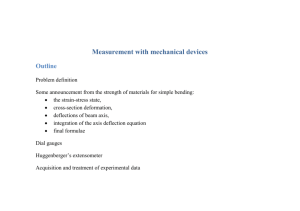


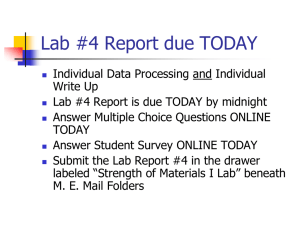
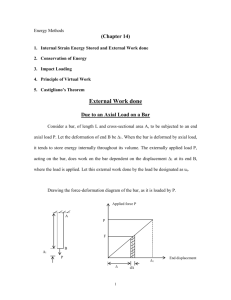
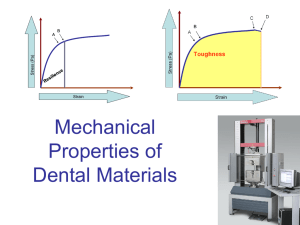
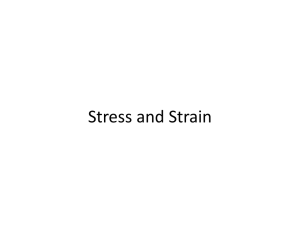
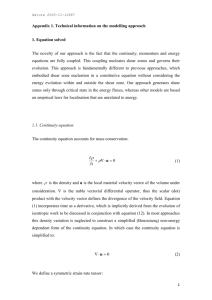
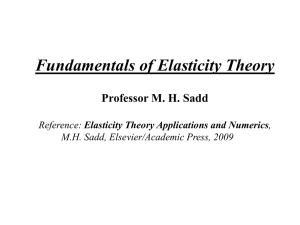


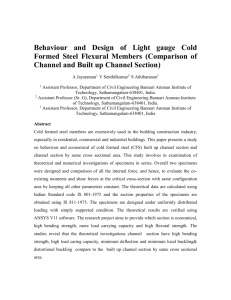
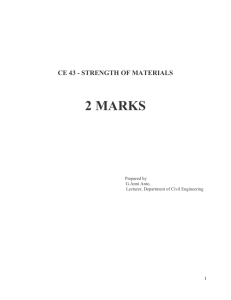
![Shear Force and Bending Moment Diagrams [SFD & BMD]](http://s2.studylib.net/store/data/005720015_1-535f2a0c845d2bd7d1466dc0f6522db3-300x300.png)